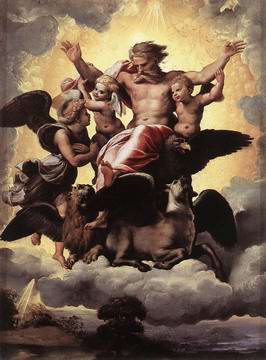Due to my schedule for the past few weeks, I have been unable to continue my weekly posts on the Sunday School lessons from the Old Testament. As I was looking over the lesson to be studied this week, I was somewhat disappointed that it did not cover some of the early chapters of the book of Ezekiel. I understand that many of the early chapters repeat themes that we have covered in Jeremiah and many of the prophets already studied. Chapter one, however, is important in that it helps connect Ezekiel to the traditions of the Temple in Jerusalem and provides a vision of the heavenly throne-chariot that was highly influential to Jewish and Christian thought for many centuries afterwards. With that in mind, and in lieu of a post on the actual chapters of Ezekiel covered by the lesson (which I haven’t managed to produce), I wanted to repost one of the first posts I wrote for this blog, entitled “Understanding Ezekiel’s Remarkable Merkabah Vision.”
—————————
In Ezekiel 1, the prophet experiences an amazing theophany that has inspired and perplexed readers for centuries. Ezekiel was privileged to see the Merkabah, the flying chariot-throne of God, and “upon the likeness of the throne was the likeness as the appearance of a man above upon it” (Ezek 1:26).

In the account that we have of this vision, we read of a whirlwind, fire, living creatures, wheels, a firmament, and other complex images. Attempts to depict what Ezekiel was seeing have been varied and rather amusing. Early Jewish and Christian writers were enamored with Ezekiel’s vision, and much time and effort was dedicated to pondering its mysteries (as can be seen in the Ma’asei Merkavah and the Kabbalah, for example). Looking past the imagery, many scholars have recognized in Ezekiel’s Merkabah the essential elements of Solomon’s Temple, which had been destroyed. If we are to understand what Ezekiel was seeing, we must look to the Temple!
Hebrew University’s Rachel Elior analyzes the similarity between the Merkabah imagery and the Temple setting. The winged cherubim of the Holy of Holies (1 Kgs 6:23–29, 8:6-7; compare Ezek. 1:5–11), the stands in the Temple court with their copper wheels (I Kings 7:27–30, 33; compare 1:10, 13-16), the four threesomes of creatures facing all four points of the compass, the lions, oxen, cherubim, and ofanim (wheels)-all made of burnished bronze –
-became four sacred winged creatures, sparkling with that same bronze luster, with the faces of lions, oxen, eagles, and human beings. They stood on four wheels (Heb. ofanim) which had the appearance of “two wheels cutting through each other” and faced all four points of the compass (Ezek 1:4–11, 16–21), like their counterparts in the Temple. The gold-plated winged cherubim in the sanctuary, whose wings were extended and “touched each other”, and which stood on their feet, were transformed in Ezekiel’s vision into sacred, sparkling, winged creatures, “each of whose wings touched those of the other” (Ezek 1:9) and whose legs “were fused into a single rigid leg” (Ezek 1:7); their appearance was “like burning coals of fire…” (Ezek 1:13). There is thus a whole system of correlations between the ideal picture of the destroyed earthly Temple and the visionary Temple revealed in heaven (Rachel Elior, The Three Temples, trans. David Louvish; Oxford: The Littman Library of Jewish Civilization, 2004).
Ezekiel saw the principal elements of the First Temple form a mobile unit which was not fixed in an earthly Temple but was a heavenly reality that could travel wherever God pleased. In essence, however, this is the vision of Isaiah (Isa 6)–Yahweh seated upon the cherub-throne in the Holy of Holies. Ezekiel was visited by this chariot-throne while in exile in Babylon, and then saw it return to the Temple in Jerusalem. In a time when the people had lost their city and their Temple but hoped to return and rebuild it again, Ezekiel’s visions gave them the assurance that God could and would be with them at all times and in all places.
—————————
If you haven’t yet seen it, my notes from Margaret Barker’s recent lecture at the Temple Studies Symposium last week has some good stuff on Ezekiel and his vision of Eden (chapter 28, also skipped by this SS lesson) and how it relates to Adam and the temple. You can see my notes here.
Also on this topic, see also the following series of videos from Professor William Hamblin’s presentation at the SANE conference at BYU in November 2008.
What is the Chariot in Ezekiel 1, Part 1
Part 2
Part 3
Continue reading at the original source →



